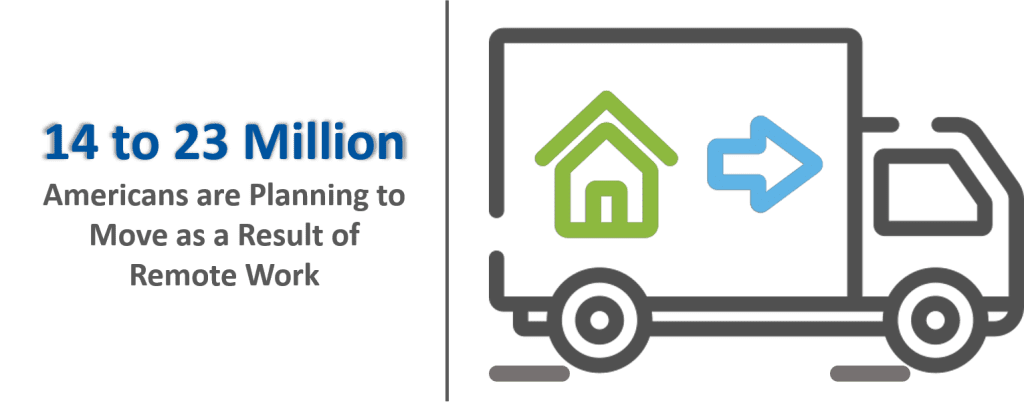Preparing for the Future of Remote Workers

Despite countless benefits, many companies have feared employing remote workers in the past. The COVID-19 pandemic has changed that by forcing many companies to quickly transition to a remote strategy. Today, with a vaccine on the horizon, those same companies are wondering what steps to take next. Should they embrace a remote strategy in the long term? What are the benefits, and how can they ensure success? Consider the following information to help determine if long-term remote work is for your company.
Remote Strategies Equate to Huge Savings
A recent survey showed that 3 out of 4 CFOs are pushing for a transition to a remote strategy. This push is due to the reduced business costs that remote companies can experience. The savings are widespread, starting with real estate. By downsizing or eliminating offices entirely, companies can save millions. Dell Computers saves $12 Million annually in real estate alone. And non-enterprise companies can benefit from real estate savings, too; when Vertical transitioned to a remote strategy nearly five years ago, they cut their real estate costs by $2 Million annually.

The savings continue. Companies that employ remote workers save on office furniture and supplies. Their utility costs are lower. Employees take fewer sick days when working in remote roles, which also saves money for the company. In fact, some studies suggest that the total savings annually per each remote employee is $1,800.
Remote Strategies Let You Hire From Anywhere
Many studies are showing that the COVID-19 pandemic has prompted moving. Individuals are moving out of major cities to escape overly populated areas, to seek less expensive housing, to change their lifestyles, and to be closer to family. A study by Upwork showed that 14 to 23 Million Americans are planning to move in response to the pandemic and the opportunity that remote flexibility provides.

Companies planning on maintaining a partial or complete remote staff can continue to benefit from these remote workers. Migration won’t change their hiring habits. Instead, companies willing to employ remote workers can widen their hiring pool. They will no longer be limited to individuals within their area or who are willing to relocate. Their unlimited hiring pool will mean they can find the ideal candidate for the exact role.
The benefits of remote employees don’t stop after they’re hired and costs are reduced. Studies show that remote employees are also more productive, by up to 13%. Remote employees often also have better health. They benefit both mentally and physically by being at home due to lower levels of stress and the ability to maintain a more flexible schedule.
Creating Long-Term Success with a Remote Strategy
When the COVID-19 pandemic hit, companies reacted quickly, moving whatever staff was possible home over night. But to be successful in the long-term, it’s important to carefully craft a remote strategy, which will guarantee that success. The right support system will help the company find success. This can be broken into two pieces: communications technology and management.
Providing Comprehensive Technology for Remote Workers
The way a team communicates is critical both in and out of office. The difference with a remote team is that managers are tasked with creating an atmosphere that employees can readily and willingly communicate in. Unlike in a physical office, employees can’t pop their head over a cubicle wall, or schedule a conference room. Instead, it’s up to managers to create a foundation of communication so that employees have the tools to quickly and efficiently communicate and so that they buy into the overall communication strategy.
Unified Communications (UC) are foundational to a remote strategy because they provide a variety of communications tools from within one platform. UC platforms often include voice, video, chat, and conferencing within a single platform. This broad selection allows employees to select the communications tool that works best for them in the moment. For a meeting, they may want to start a video conference so they can readily communicate and see everyone’s faces, or share their screen. For a quick question, they may opt for an instant message. Users can also create group chats, allowing entire teams to quickly update each other on a status. Some UC platforms integrate with email carriers like Outlook and Gmail, allowing users to quickly join or schedule meetings from within their calendar. No matter their need, they have an option. Even better, they only need to use one platform, decreasing time spent moving between platforms and learning different platforms.
Cloud UC platforms provide the added benefit of allowing remote employees to access the platform from multiple devices. Users can utilize any of the communications features from their desk phone, computer, or even from their mobile phone, all using the same business number. As remote workers may be flexible in the way they work, it’s beneficial that they can communicate no matter what their circumstance. Even better, their user experience will always be the same, allowing them to work efficiently.
After selecting a UC platform, it is also crucial to set a standard of using the platform. For a remote strategy to be a success, all users have to buy in. If the leadership consistently uses the platform for meetings and calls, reaches out via chat, and updates their status on the UC platform, their team will likely follow suit.
The first step to success in a long-term remote strategy is learning where the gaps are in your critical applications and capabilities. Vertical can help. Use Vertical’s “Telework Toolkit” to see what gaps you may be unaware of, and then build your plan to address them.
Remote Employee Management
Managing a remote team shares many similarities as managing an on-site team- but there are some pretty big differences, too. For success with a remote strategy, managers need to adapt their management style. Consider the following steps to success:
- Set work hours to minimize over work. In an office, it’s easy to set an obvious end point to a work day. At home, remote workers tend to over work, and can eventually face burnout. To get the most out of employees (and hold on to them for the long-term), set policies to clearly delineate work hours and consider “no email” hours.
- Consider flexible scheduling. When employees are at home they juggle additional responsibilities and distractions. To help them balance it all, consider including flexible scheduling in your remote policies. Successful flexible scheduling focuses on goal accomplishment rather than work hours.
- Embrace over communication – It can be harder to communicate remotely, and passive communication disappears. This means many remote workers fear being out of the loop. To help, set policies to ensure over communication, both within teams and cross-departmental. Company knowledge bases, internal newsletter, and daily standups are beneficial.
- Ensure good supervision. Remote supervision takes effort and must be intentional. Remote work means employees can’t just pass by a desk or office, or have a quick conversation in the hallway. To guarantee good supervision, supervisors should schedule a daily touch base, schedule regular meetings to discuss concerns, and encourage informal talk.
- Work on video meeting etiquette. Remote workers are more isolated so all meeting attendees need to make an effort to show they’re involved. Attendees should turn on video, react to those who are talking, avoid multi-tasking, and be aware of muted status.
- Create an understanding work culture. Remote work conditions can be more challenging due to distractions, family members, pets, etc. Set a standard of understanding company-wide. The policy should ensure that there is no judgement for interruptions and fashion and that feedback is provided gently.
Getting Started with a Long-Term Remote Strategy
There are a lot of solutions out there and it’s critical that you find the right one for your needs. Vertical can help! Vertical has been a remote company for 4+ years. We’ve already gone through the transition to a remote strategy. We can help you learn from our mistakes and benefit from our experience.



